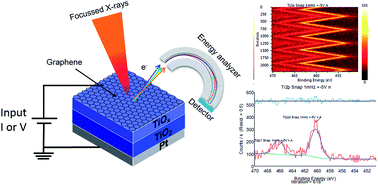当前位置:
X-MOL 学术
›
Faraday Discuss.
›
论文详情
Our official English website, www.x-mol.net, welcomes your
feedback! (Note: you will need to create a separate account there.)
Chemically addressed switching measurements in graphene electrode memristive devices using in situ XPS
Faraday Discussions ( IF 3.3 ) Pub Date : 2018-08-06 , DOI: 10.1039/c8fd00129d Itır Köymen 1, 2, 3, 4 , Pınar Aydoğan Göktürk 2, 3, 4, 5 , Coşkun Kocabaş 6, 7, 8 , Şefik Süzer 2, 3, 4, 5
Faraday Discussions ( IF 3.3 ) Pub Date : 2018-08-06 , DOI: 10.1039/c8fd00129d Itır Köymen 1, 2, 3, 4 , Pınar Aydoğan Göktürk 2, 3, 4, 5 , Coşkun Kocabaş 6, 7, 8 , Şefik Süzer 2, 3, 4, 5
Affiliation

|
The memristor has been the topic of heated research activity since the Pt/TiO2/TiOx/Pt structure was reported by Hewlett-Packard Labs. The characteristics of memristors such as the pinched hysteresis loops and time and input signal-dependent memristance are due to the drift of positively charged oxygen vacancies in the TiOx layer. While different modes of switching behaviour have been characterized, observing the switching as it happens with in situ measurements using X-ray photoelectron spectroscopy (XPS) can allow a better understanding of the device operation. The setup used in this work enables the application of voltage signals of different frequencies and amplitudes and observing the hysteresis seen in the I–V plane through chemical addressing. The measurements were conducted on Pt/TiO2/TiOx/graphene structures. The single layer graphene, utilized as a top electrode, effectively acts as a transparent electrode in that the layer beneath it can be observed to a depth of ∼10 nm in XPS. This allows for the observation of the changes in the binding energies of C 1s, Ti 2p and O 1s. By comparing the variation in the binding energy of Ti 2p to that of C 1s, and observing how the variation changes for different excitation signals (at different frequency and amplitudes), it is possible to inspect the effect of the oxygen vacancy drift. We employed a variety of input signals with varying frequency and amplitudes in order to test the memristive devices thoroughly: sine wave, triangular wave and DC bias. Graphene has been attracting attention due to its intriguing optoelectronic properties. This study utilizes graphene as a transparent top electrode for in situ measurements in XPS to observe chemically-addressed memristive hysteresis while an excitation signal is being applied to the device.
中文翻译:

使用原位XPS在石墨烯电极忆阻器件中进行化学寻址的开关测量
自Hewlett-Packard Labs报告Pt / TiO 2 / TiO x / Pt结构以来,忆阻器一直是研究热点。忆阻器的特性,例如收缩的磁滞回线,时间和与输入信号有关的忆阻,是由于TiO x层中带正电荷的氧空位的漂移所致。尽管已表征了不同的开关行为模式,但使用X射线光电子能谱(XPS)进行原位测量时观察开关的变化,可以更好地了解设备的运行情况。在这项工作中使用的设置可以施加不同频率和幅度的电压信号,并观察I中看到的磁滞。– V平面通过化学寻址。测量在Pt / TiO 2 / TiO x上进行/石墨烯结构。用作顶部电极的单层石墨烯有效地用作透明电极,因为在XPS中可以观察到其下方的层达约10 nm的深度。这允许观察C 1s,Ti 2p和O 1s的结合能的变化。通过比较Ti 2p与C 1s的结合能的变化,并观察不同激发信号(在不同的频率和振幅下)的变化如何变化,可以检查氧空位漂移的影响。为了彻底测试忆阻器件,我们采用了各种具有不同频率和幅度的输入信号:正弦波,三角波和直流偏置。石墨烯因其令人着迷的光电特性而备受关注。在XPS上进行原位测量,以在将激励信号施加到设备时观察化学寻址的忆阻滞后现象。
更新日期:2019-02-19
中文翻译:

使用原位XPS在石墨烯电极忆阻器件中进行化学寻址的开关测量
自Hewlett-Packard Labs报告Pt / TiO 2 / TiO x / Pt结构以来,忆阻器一直是研究热点。忆阻器的特性,例如收缩的磁滞回线,时间和与输入信号有关的忆阻,是由于TiO x层中带正电荷的氧空位的漂移所致。尽管已表征了不同的开关行为模式,但使用X射线光电子能谱(XPS)进行原位测量时观察开关的变化,可以更好地了解设备的运行情况。在这项工作中使用的设置可以施加不同频率和幅度的电压信号,并观察I中看到的磁滞。– V平面通过化学寻址。测量在Pt / TiO 2 / TiO x上进行/石墨烯结构。用作顶部电极的单层石墨烯有效地用作透明电极,因为在XPS中可以观察到其下方的层达约10 nm的深度。这允许观察C 1s,Ti 2p和O 1s的结合能的变化。通过比较Ti 2p与C 1s的结合能的变化,并观察不同激发信号(在不同的频率和振幅下)的变化如何变化,可以检查氧空位漂移的影响。为了彻底测试忆阻器件,我们采用了各种具有不同频率和幅度的输入信号:正弦波,三角波和直流偏置。石墨烯因其令人着迷的光电特性而备受关注。在XPS上进行原位测量,以在将激励信号施加到设备时观察化学寻址的忆阻滞后现象。











































 京公网安备 11010802027423号
京公网安备 11010802027423号